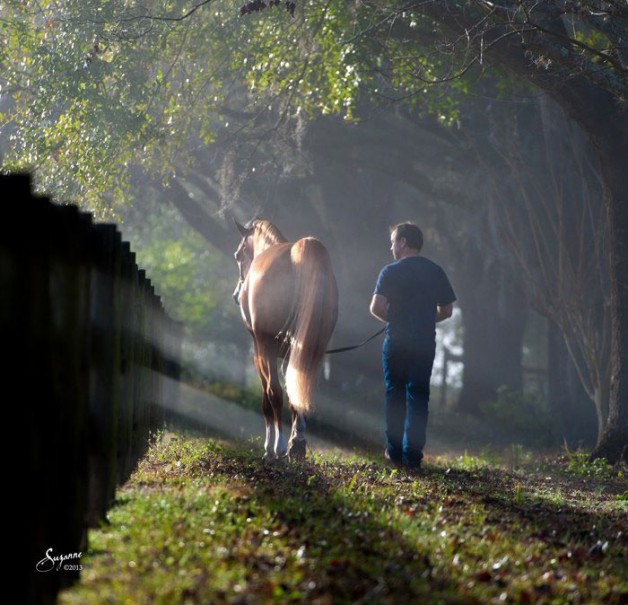By Christa Lesté-Lasserre, MA
Horses do, in fact, try to intentionally communicate with us to achieve certain goals.
“Hey! See that bucket of feed over there? Yeah, that one. Can you grab that for me, please? I’m kind of hungry.”
Wait a minute. Did your horse just speak to you? Actually, he might have—in his own way, of course. New research by European scientists has revealed that horses do, in fact, try to intentionally communicate with us to achieve certain goals.
In their pioneering study, researchers have determined for the first time that horses are capable of heterospecific referential communication—essentially, the ability to communicate about something, specifically to someone else. More precisely, to us.
So does that mean our horses actually “talk” to us?
“They sure do,” said Rachele Malavasi, PhD, of the School of Ethical Equitation, in Moncigoli Di Fivizzano, Italy. Malavasi carried out her research in association with Ludwig Huber, PhD, professor at the Comparative Cognition Unit at the Messerli Research Institute at the University of Veterinary Medicine of Vienna in Austria.
“Horses are social animals which have evolved skills to maintain their social unity: affiliative relationships, protection from outsiders, social facilitation, and even social learning,” Malavasi explained. “We know now that their skill set also includes the ability to communicate intentionally with humans.”
In their study of 14 horses’ behavior, Malavasi and Huber placed two buckets just out of each horse’s reach. Each bucket contained either carrots, apples, or oats—as at least one of these treats would be likely to attract each horse, they said. The horse and handler stood inside a fenced-in area where they could see the buckets on opposite sides of the enclosure, just past a gate.
The handler did nothing but stand there. The horse, therefore, had to figure out a way to communicate to the handler: “Get me that bucket!” And so they did. In fact, for the most part, they did whatever it took to get the message across.
“The horses would alternate their gaze between the human and the reward (bucket), with the aim of conveying the attention of the experimenter to the desired reward,” Malavasi said. “But if that didn’t work, the horses would demonstrate real flexibility in their communicative strategies. They would nod their heads, turn their tails, and move their heads quickly toward the rewarded bucket in a ‘pointing’ kind of behavior.”
What’s more, the horses only made such great efforts when the human was actually looking at them, she said. The scientists instructed the “test” human to turn her body in different directions—as horses do appear to be able to detect a human’s attention toward them. When the humans seemed to not be paying attention, the horses first tried to get their attention before communicating about the food bucket.
“The horses searched for eye contact with the experimenter by turning their heads back to the experimenter,” said Malavasi. “But if they didn’t obtain the reward, they would switch to another strategy, where they walked back to the experimenter and touch her.”
Until now, the only domestic animal shown to be capable of heterospecific referential communication is the dog, she said. Now that we know that horses can do it, too, it’s possible to extrapolate the significance of the findings even further—as it suggests that horses are capable of thought-out problem-solving.
“Having this ability means that horses do not just ‘behave’ without considering the consequence of their actions,” she said. “Rather, they are able to create a mental plan (for example, to reach a goal with the help of others around them), to evaluate the attentional state of that audience, and to modify their communicative strategy accordingly. Horses seem therefore able of iterative problem solving strategy.”
While all horses probably have the ability to intentionally communicate with us, many handlers don’t see it, Malavasi said. And some horses might have “given up” on trying to communicate with us, she said, especially if they have experienced learned helplessness through constant isolation and/or abuse.
“I recommend spending some time doing nothing but observing your horse in the field, if not with other horses, then alone,” Malavasi said. “Horse people need to know how horses communicate and especially how their own horses communicate.
“We found some horses were very ‘talkative,’ whereas others would use very subtle signals,” she added. “Learning the communicative strategies of your own horse is like getting to know another person: You’ll never stop learning, but the more you know, the more you love.
“It’s also possible that your horse has given up in communicating with you, because you never listen,” she continued. “That’s an unfortunate situation, but it can be fixed. If you don’t know what your horse wants, be creative, and test solutions. It could be a great game to play together, and you’re sure to see a positive change in your horse’s attitude!”



